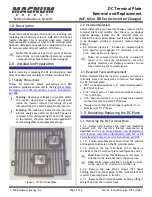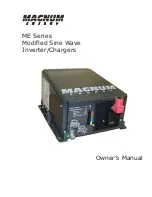
— 64 —
Interval (sec)
is the period, in seconds, between repeated trans-
missions of data bursts. Any value between 001 seconds and
999 seconds (16+ minutes) may be entered here.
Repeat
is the
number of data repetitions in each burst, equivalent to (n) in
RAW(n)= . A number between 1 and 9 is entered here.
ODA Da-
ta to Repeat
is the same “RAW” data discussed earlier, for the B,
C and D RDS data groups.
For example, the sample entry
shown here would send the three
hexadecimal values
6000
,
4142
and
4344
in the B, C and D RDS
groups of the 6A (‘In-House’) pack-
et, respectively. Each burst, or
successive repetition of the groups,
would repeat the data
5
times, and this would keep repeating
every
15
seconds. In this example the
ODA2=
group is disabled,
although it could be programmed for another application.
To format this same information using the Terminal program,
the command would be:
ODA1=015,5,600041424344
. This
same formatting would hold true for a controlling computer or
process-instrumentation system.
The Scheduler utility built into the 730 Encoder may also be
used to transmit these
ODA1=
and
ODA2=
commands auto-
matically, according to a day-or-date and time schedule. This
option is described on Page 34.
DATA INTERCONNECTION
For dynamic operation of the 730, the rear-panel
RS-232 SERI-
AL DATA INTERCONNECT
port is addressed in simple ASCII
text. The primary utility of this port is to connect with station
automation for uploading scrolling-PS and Radio Text messag-
es. Communication syntax for direct connection with automa-
tion was explained on Page 59 and in the Appendix.
The various RDS flags and other static data should already have
been programmed per the instructions in Section III.
Computer or
Terminal
Requirements
Although the supplied Windows® software and front-panel USB
port afford the easiest method of entering static RDS data, the
encoder may also be addressed serially using the Terminal util-
ity in the 730 Encoder software (see Page 31). A simple “dumb”
RS-232 terminal and, of course, station automation may also
address the encoder directly. The encoder can accommodate
multiple baud rates with a factory default setting of 9600 baud.
Set terminal or automation for: 9600-baud/8 data bits/no pari-
ty/one stop bit (9600,8,N,1).
Interconnect
Cables
When the 730 is connected to a computer for static program-
ming, the front-panel USB port is by far the most convenient
means, and a USB cable has been included with the encoder.
Serial-port connection with station automation for dynamic















































